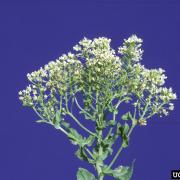Invasive Species: Cardaria draba, Hoary Cress
Hoary cress, or whitetop, is an invasive perennial forb in the mustard family that can grow up to 2 ft. (0.6 m) tall. The leaves are soft, gray-green, 1.5 to 3 in. (3.7 to 7.6 cm) long with fine hairs and heart-shaped bases. The lower leaves tend to have more hairs than the upper leaves. The upper leaves clasp to the stem of the plant. Flowering occurs in early spring to early summer when white four-petaled flowers develop in clusters at the apex of the stem. The fruit are heart-shaped seed pods. Hoary cress invades rangelands, pastures, stream banks, and open forests primarily in the western United States, although it does occur in the East. It can form large infestations that can displace native species and reduce grazing quality. Hoary cress is native to Central Europe and Western Asia and was first introduced into the United States in the early 20th century.
What are invasive species and why should we be concerned about them?
Taxonomy: Scientific and Common Names for This Species
Capparales > Brassicaceae > Cardaria draba (L.) Desv
Synonym(s): whitetop, globed-podded hoarycress, peppergrass, whiteweed
Cardaria draba – USDA PLANTS Profile
Distribution Maps
Hoary cress – The reported distribution of this invasive species across the United States. (Source: Invasive Plant Atlas of the United States)
Up-to-the-minute distribution maps and why they are important
Reporting This Invasive Species
What is the best way and place to report the occurrence of an invasive species?
How to report an invasive species sighting to EDDMapS – Early Detection & Distribution Mapping System
EDDMapS – Report an invasive species to EDDMapS
Cooperative Extension Offices – Find your local Cooperative Extension office on this map provided by USDA
How to Identify
This invasive species can be identified by looking for the characteristics described in the paragraphs that follow.
Plant
An invasive perennial forb in the mustard family that can grow up to 2 ft. (0.6 m) tall.
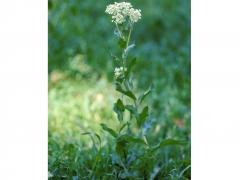 |
 |
| Barry Rice, sarracenia.com, bugwood.org | Steve Dewey, Utah State University, bugwood.org |
Foliage
The leaves are soft, gray-green, 1.5 to 3 in. (3.7 to 7.6 cm) long with fine hairs and heart-shaped bases. The lower leaves tend to have more hairs than the upper leaves. The upper leaves clasp to the stem of the plant.
 |
 |
| Pedro Tenorio-Lezama, bugwood.org | Pedro Tenorio-Lezama, bugwood.org |
Flower
Flowering occurs in early spring to early summer when white four-petaled flowers develop in clusters at the apex of the stem.
|
|
 |
|
Steve Dewey, Utah State University, |
Barry Rice, sarracenia.com, bugwood.org |
Fruit
The fruit are heart-shaped seed pods.
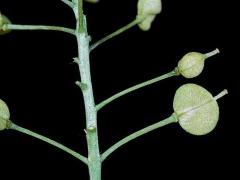 |
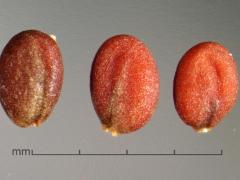 |
| Joseph M. DiTomaso, University of California – Davis, bugwood.org | Julia Scher, USDA APHIS PPQ, bugwood.org |
Native Species That Resemble Hoary Cress
Oxypolis filiformis, water cowbane – Images at invasive.org
 |
 |
| Karan A. Rawlins, University of Georgia, bugwood.org | Karan A. Rawlins, University of Georgia, bugwood.org |
Oxypolis fendleri, Fendler’s cowbane – Images at invasive.org
 |
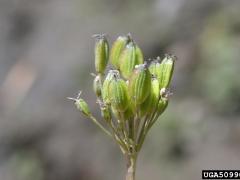 |
| Dave Powell, USDA Forest Service, bugwood.org | Mary Ellen (Mel) Harte, bugwood.org |
Additional Images for Hoary Cress
Hoary cress – Images at Invasive.org
Learning Resources for Hoary Cress
Additional Information, Biology, Control and Management Resources
Control and management recommendations vary according to individual circumstances. Location, habitat, weather, and a variety of other conditions are factors that help determine the best treatment choice. To find the safest and most effective treatment for your situation, consult your state’s land-grant institution. If you will use chemicals as part of the control process, always refer to the product label.
United States Land-Grant University System – Find your land-grant university’s College of Agriculture, Cooperative Extension Service, or other related partner on this map provided by USDA.
Element Stewardship Abstract – The Nature Conservancy
Federal Noxious Weed Disseminules of the U.S. – USDA-APHIS
Weed of the Week – USDA Forest Service
Cardaria draba – Missouri Plants
Jepson Herbarium – University of California
Plant Profile – Cal-IPC
Invasive Plant Management – Cal-IPC

